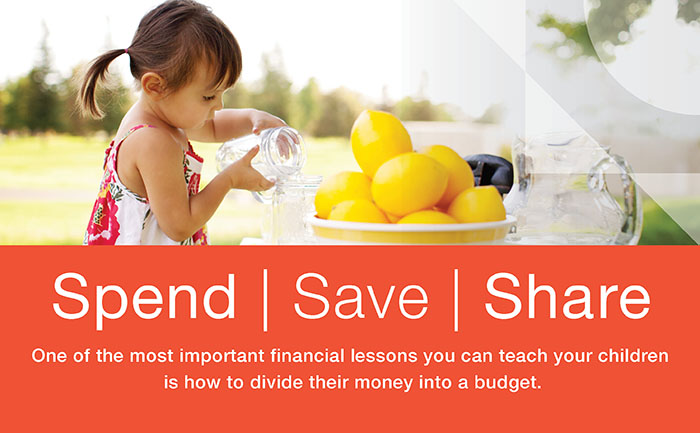How to teach your children to spend, save, and share
As a parent, you’re always looking for new opportunities to teach your children lasting, life-long lessons. A proud moment in every parent’s life is teaching your children about financial responsibility. Whether you’ve started giving your children an allowance or they’ve earned some extra money from helping with chores in your neighborhood, it’s never too early or too late to start teaching them valuable financial lessons.
One of the most important financial lessons you can teach your children is how to divide their money into a budget. This not only teaches your children financial discipline, but it also shows them how to budget and what to use their money for at an early age.

An easy activity to teach your children this lesson1 is to create a visual representation of three simple ways to use money — to spend, save, and share.
Step 1: To get started, select a way to store physical money, like a clear jar.
This is particularly helpful for young children as they can watch their money grow and take their money with them to the store. For this activity, you’ll need three separate jars that can be labeled “Spend”, “Save”, and “Share”.
Each jar’s intention represents a valuable lesson for your children and is used in three distinct ways.
The spend jar teaches your children what they can buy with their money. The money in this jar should be used in the way that your child chooses, like to purchase a new toy or get ice cream.
The save jar helps your children learn delayed gratification by encouraging them to save up for a more expensive purchase, like a new bike or scooter.
The share jar shows your children how money can be used in socially responsible ways by letting them give money to a cause they care about.
Once you label the jars, you can even ask your children to help decorate them in their own style as part of this activity.
Step 2: Next, explain what each jar is used for and help set a healthy budget.
It’s important to help set budgeting guidelines for each jar in a way that works for your children. To do so, an easy rule of thumb is to help divide their allowance or money into even thirds. Then, set additional boundaries around how often each jar can be used, particularly the save jar. This will help avoid any confusion about the intention of each jar, especially when it comes to saving vs. spending.
Although this is one method for budgeting in this activity, there are other ways to divide the money. For example, perhaps you know your children would like to save towards a larger purchase. Encourage them to put 50 percent of their money in the save jar, 25 percent in the spend jar, and 25 percent in the share jar. In other instances, it may make sense to put 50 percent in the spend jar and divide the rest evenly between the save and share jars.
Regardless of the method you select, it’s important to be consistent so your children start to know what to expect and how much money should go into each jar.
Step 3: Finally, reward your children for being financially disciplined in tangible ways.
As the money in your children’s jars begin to grow, it’s important to reinforce this lesson in positive, tangible ways.
- With the spend jar, your children can make smaller purchases at stores with you.
- To use the save jar, remind your children of their goal to save for a larger purchase as other smaller purchases may seem tempting. Then, once they’ve achieved their saving goal, take them to purchase the item.
- Lastly, to reinforce the tangible ways the share jar can be used, seek opportunities where your children can exchange their money for tangible goods and use them to make a positive impact. For example, your child could purchase food and donate it to a local pantry.
As you make a habit of this lesson, your children can learn how to allocate money at an early age, while reinforcing values beyond saving, spending, and sharing.
Sharing Knowledge. Building Trust.
At Westfield Bank, we believe that personalized service and convenient financial services are just the beginning of what banks can offer. We believe in investing in our community, the people who live there, and our collective future.



